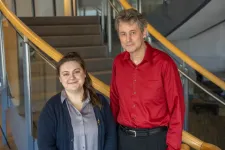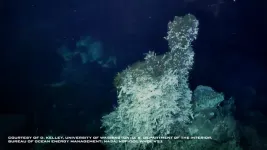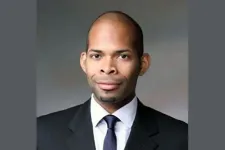(Press-News.org) Thanks to data from a magnified, multiply imaged supernova, a team led by University of Minnesota Twin Cities researchers has successfully used a first-of-its-kind technique to measure the expansion rate of the Universe. Their data provide insight into a longstanding debate in the field and could help scientists more accurately determine the Universe’s age and better understand the cosmos.
The work is divided into two papers, respectively published in Science, one of the world’s top peer-reviewed academic journals, and The Astrophysical Journal, a peer-reviewed scientific journal of astrophysics and astronomy.
In astronomy, there are two precise measurements of the expansion of the Universe, also called the “Hubble constant.” One is calculated from nearby observations of supernovae, and the second uses the “cosmic microwave background,” or radiation that began to stream freely through the Universe shortly after the Big Bang.
However, these two measurements differ by about 10 percent, which has caused widespread debate among physicists and astronomers. If both measurements are accurate, that means scientists’ current theory about the make-up of the universe is incomplete.
“If new, independent measurements confirm this disagreement between the two measurements of the Hubble constant, it would become a chink in the armor of our understanding of the cosmos,” said Patrick Kelly, lead author of both papers and an assistant professor in the University of Minnesota School of Physics and Astronomy. “The big question is if there is a possible issue with one or both of the measurements. Our research addresses that by using an independent, completely different way to measure the expansion rate of the Universe.”
The University of Minnesota-led team was able to calculate this value using data from a supernova discovered by Kelly in 2014—the first ever example of a multiply imaged supernova, meaning that the telescope captured four different images of the same cosmic event. After the discovery, teams around the world predicted that the supernova would reappear at a new position in 2015, and the University of Minnesota team detected this additional image.
These multiple images appeared because the supernova was gravitationally lensed by a galaxy cluster, a phenomenon in which mass from the cluster bends and magnifies light. By using the time delays between the appearances of the 2014 and 2015 images, the researchers were able to measure the Hubble Constant using a theory developed in 1964 by Norwegian astronomer Sjur Refsdal that had previously been impossible to put into practice.
The researchers’ findings don’t absolutely settle the debate, Kelly said, but they do provide more insight into the problem and bring physicists closer to obtaining the most accurate measurement of the Universe’s age.
“Our measurement favors the value from the cosmic microwave background, although it is not in strong disagreement with the supernova value,” Kelly said. “If observations of future supernovae that are also gravitationally lensed by clusters yield a similar result, then it would identify an issue with the current supernova value, or with our understanding of galaxy-cluster dark matter.”
Using the same data, the researchers found that some current models of galaxy-cluster dark matter were able to explain their observations of the supernovae. This allowed them to determine the most accurate models for the locations of dark matter in the galaxy cluster, a question that has long plagued astronomers.
This research was funded primarily by NASA through the Space Telescope Science Institute and the National Science Foundation.
In addition to Kelly, the team included researchers from the University of Minnesota’s Minnesota Institute for Astrophysics; the University of South Carolina; the University of California, Los Angeles; Stanford University; the Swiss Federal Institute of Technology Lausanne; Sorbonne University; the University of California, Berkeley; the University of Toronto; Rutgers University; the University of Copenhagen; the University of Cambridge; the Kavli Institute for Cosmology; Ben-Gurion University of the Negev; University of the Basque Country; the University of Cantabria; Consejo Superior de Investigaciones Cientificas (the Spanish National Research Council); the Observatories of the Carnegie Institution for Science; the University of Portsmouth; Durham University; the University of California, Santa Barbara; the University of Tokyo; the Space Telescope Science Institute; the Leibniz Institute for Astrophysics Potsdam; the University of Michigan; Australian National University; Stony Brook University; Heidelberg University; and Chiba University.
END
First-of-its-kind measurement of the Universe’s expansion rate weighs in on a longstanding debate in physics and astronomy
University of Minnesota-led research could help more accurately determine the Universe’s age
2023-05-11
ELSE PRESS RELEASES FROM THIS DATE:
Historic achievement for international penile cancer trial--100 patients enrolled thus far, the most ever to a prospective study for treatment of an extremely rare disease
2023-05-11
Cancer of the penis is not a subject that comes up in conversation. When it does, one common response is, “I didn’t know you could get cancer there.” Not only is it not spoken about, but it is also rare, with fewer than one case per 100,000 men diagnosed in developed countries like the United States and the United Kingdom per year. That rarity has meant far fewer clinical trials have been developed and conducted to guide its treatment, and in most cases, only small numbers of patients have been included. Fortunately, researchers from both sides ...
Getting active, while living with a partial spinal cord injury
2023-05-11
A UBC Okanagan researcher has been testing the effectiveness of a mobile app that encourages people living with a spinal cord injury—but can walk—to get active.
Dr. Sarah Lawrason, a researcher in the School of Health and Exercise Sciences, has focused her career on working with people who live with a spinal cord injury (SCI) but are ambulatory. She describes this population as an isolated, often misunderstood group of people because while they live with an SCI, they may not rely on a wheelchair all of the time for mobility.
“When people think of someone with an SCI, they picture a ...
New, free online language course helps you learn Ojibwe
2023-05-11
TORONTO – May 11, 2023 – With funding from Canada’s Social Sciences and Humanities Research Council (SSHRC), Baycrest, the Kingston Indigenous Language Nest (KILN) and the University of Toronto have released a free online language course to learn the Indigenous language Ojibwe, also known as Anishinaabemowin.
The Ojibwe language is spoken in Indigenous communities around the Great Lakes in Canada and the US, but serious efforts are needed to ensure the long-term survival of the language.
“Due to the aging of people who ...
New research sheds light on the causes of fatigue after COVID 19
2023-05-11
Experts from Newcastle University found the nervous system of people with post-Covid fatigue was underactive in three key areas. Fatigue is one of the most common symptoms of long Covid.
The breakthrough could lead to better treatment and tests to identify the condition and the team are already progressing the work having just started a trial. They have begun recruiting patients to test the effectiveness of a TENS machine – commonly used for pain relief in childbirth – to alleviate the fatigue in patients with long Covid.
Newcastle University ...
Into the Blue: Securing a sustainable future for kelp forests
2023-05-11
Into the Blue: Securing a Sustainable Future for Kelp Forests global synthesis report is the most comprehensive knowledge review on kelp to date, revealing the state of science on the world’s kelp forests and providing recommended actions to build the recovery of the world’s kelp forests.
Aiming to improve our understanding of the value of kelp forests and provide recommendations to protect and sustainably manage them, the report also provides a range of policy and management interventions and options that can be used to maintain these remarkable ecosystems into the future and to support the people and economies that have depended on them for generations.
Despite ...
Heavy drinking poses even greater risk for one in three Americans
2023-05-11
LOS ANGELES — Two people regularly have a few alcoholic drinks daily. One develops liver disease. The other doesn’t.
What explains the different outcomes?
The answer may lie in a condition known as metabolic syndrome, a cluster of conditions that together raise the risk of coronary heart disease, diabetes, stroke and other serious health problems. This syndrome, characterized by symptoms such as abdominal fat, high blood pressure, high cholesterol and high blood sugar, affects more than one in three Americans.
A new ...
Gene linking circadian and circatidal rhythms is discovered in tiny crustacean
2023-05-11
Scientists at UMass Chan Medical School and the Marine Biological Laboratory at Woods Hole have identified the first gene—Bmal1—to play a crucial role in regulating circatidal behavior in the crustacean Parhyale hawaiensis. Circatidal rhythms help animals cope with the rise and fall of the tides in coastal areas.
Published in Current Biology, the study by neurobiologists Patrick Emery, PhD, Joshua Rosenthal, PhD, and colleagues demonstrates the first molecular link between circatidal and circadian ...
Fire hydrant hydrophones find water leaks #ASA184
2023-05-11
CHICAGO, May 11, 2023 – Access to clean drinking water is essential for healthy communities, but delivering that water is growing increasingly difficult for many utilities. Corroding pipes and land shifts in aging water distribution networks can create frequent leaks, wasting water before it ever gets to the tap. Utilities in the U.S. lose about 6 billion gallons of water a day — enough to fill 9,000 swimming pools — due to leaks, in addition to wasted energy and resources spent in collecting and treating that water.
Pranav Agrawal and Sriram Narasimhan from the University ...
InVADER mission to test its robotic laser divebot on a deep-sea expedition
2023-05-11
InVADER Mission to Test its Robotic Laser Divebot on a Deep-Sea Expedition
Team to test technologies for use in future planetary exploration while providing data to survey deep-sea ecosystems and minerals on Earth
May 11, 2023, Mountain View, CA – A team of scientists and engineers from the SETI Institute, Impossible Sensing, NASA JPL, and other institutions will test their innovative robotic laser system on a deep-sea expedition aboard the E/V Nautilus. The mission, called InVADER (In-situ Vent Analysis Divebot for Exobiology Research), aims to advance technologies to explore, ...
Rensselaer researcher uses artificial intelligence to discover new materials for advanced computing
2023-05-11
A team of researchers led by Rensselaer Polytechnic Institute’s Trevor David Rhone, assistant professor in the Department of Physics, Applied Physics, and Astronomy, has identified novel van der Waals (vdW) magnets using cutting-edge tools in artificial intelligence (AI). In particular, the team identified transition metal halide vdW materials with large magnetic moments that are predicted to be chemically stable using semi-supervised learning. These two-dimensional (2D) vdW magnets have potential applications in data storage, spintronics, and even quantum computing.
Rhone ...
LAST 30 PRESS RELEASES:
NTIDE: Disability employment holds steady after data hiatus
Social lives of viruses affect antiviral resistance
Dose of psilocybin, dash of rabies point to treatment for depression
Helping health care providers navigate social, political, and legal barriers to patient care
Barrow Neurological Institute, University of Calgary study urges “major change” to migraine treatment in Emergency Departments
Using smartphones to improve disaster search and rescue
Robust new photocatalyst paves the way for cleaner hydrogen peroxide production and greener chemical manufacturing
Ultrafast material captures toxic PFAS at record speed and capacity
Plant phenolic acids supercharge old antibiotics against multidrug resistant E. coli
UNC-Chapel Hill study shows AI can dramatically speed up digitizing natural history collections
OYE Therapeutics closes $5M convertible note round, advancing toward clinical development
Membrane ‘neighborhood’ helps transporter protein regulate cell signaling
Naval aviator turned NPS doctoral student earns national recognition for applied quantum research
Astronomers watch stars explode in real time through new images
Carbon-negative building material developed at Worcester Polytechnic Institute published in matter
Free radicals caught in the act with slow spectroscopy
New research highlights Syntax Bio’s platform for simple yet powerful programming of human stem cells
Researchers from the HSE University investigated reading in adolescents
Penn Nursing study: Virtual nursing programs in hospitals fall short of expectations
Although public overwhelmingly supports hepatitis B vaccine for a newborn, partisan differences exist
DFW backs UTA research to bolster flood resilience
AI brain scan model identifies stroke, brain tumors and aneurysms – helping radiologists triage and speed up diagnoses
U.S. News & World Report gives Hebrew Rehabilitation Center highest rating
Optica and DPG name Antoine Browaeys 2026 Herbert Walther Award recipient
The presence of a gun in the home increases the risk of suicide by three to five times
PFAS exposure and endocrine disruption among women
Vaccines and the 2024 US presidential election
New approach narrows uncertainty in future warming and remaining carbon budget for 2 °C
When pregnancy emergencies collide with state abortion bans
American College of Cardiology supports front of package nutrition labeling
[Press-News.org] First-of-its-kind measurement of the Universe’s expansion rate weighs in on a longstanding debate in physics and astronomyUniversity of Minnesota-led research could help more accurately determine the Universe’s age









